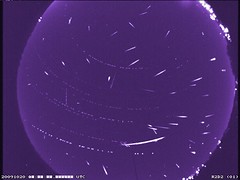Skywatchers have an ideal opportunity this month to see one of the most reliable annual displays of “shooting stars” plus the rising of the two brightest planets on opposite horizons. And all this couldn’t happen at a better time, for October typically has not only some of the best skies of the year for viewing but also on average the greatest number of clear nights.
The Orionid Meteor Shower will provide another fine display of celestial fireworks as it reaches peak activity during the evening hours of the 21st into the morning of the 22nd, maximum itself coming sometime before dawn. The Moon will interfere somewhat after midnight, being just two days past Last Quarter. As many as two dozen shooting stars will be seen under good sky conditions (or about one every two minutes).
While not one of the richer showers, it’s radiant (the point from which the meteors appear to “shoot”) is located in a glorious part of the heavens — that of magnificent Orion! The actual point lies between ruddy-orange Betelgeuse in the Hunter’s shoulder and the feet of Gemini the Twins to its northeast. Although the two constellations themselves won’t completely clear the horizon until around 11 p.m. local time on the 21st, meteors will be visible streaming over the northeastern horizon beforehand. They are typically best-seen some distance from the radiant itself, so facing in its direction and looking overhead gives the best results. And reclining comfortably on a lawn chair definitely helps during such vigils! In order to survey as large an area of sky as possible, observing shooting stars is essentially a naked-eye activity—no telescope needed here!
As a point of interest, meteor showers result from our “Spaceship Earth” in its 66,000 mph orbit of the Sun running into streams of debris each year left behind by various comets in during their visits to the inner solar system. In the case of the Orionids, their source is perhaps the most famous of all such object—none other than Halley’s Comet itself. In a real sense, we get to see pieces of Halley every year!
An added bonus for stargazers in October this year is the opportunity to see the two brightest planets both rising in the sky and beginning their month’s-long evening apparitions. As the month opens, Venus makes its initial appearance low above the western horizon after sunset. It continues to move eastward and somewhat higher in the sky each night, and by the 31st it’s quite unmistakable as our “Evening Star” above the southwestern horizon. (It will continue its accent all the way into December, at which time it becomes this year’s radiant “Christmas Star.”) On the other side of the sky, Jupiter reaches “opposition” on October 28th, which means that it rises over the eastern horizon as the Sun sets over the western one and remains visible all night. But it can be seen soon after darkness falls all month long. As discussed in past columns, steadily-held (good quality) binoculars and small telescopes will show its gem-like satellites changing position about the planet from night-to-night.
—James Mullaney
Former assistant editor at Sky & Telescope magazine and author of eight books on stargazing.


